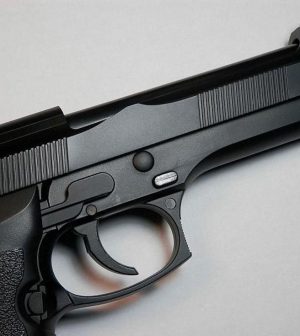- Skip Storing This Everyday Product in the Fridge Door
- Green Tea + B3 Pairing May Boost Brain Health
- Navigating Your Midlife Crisis: Embracing New Possibilities
- City Raccoons Showing Signs of Domestication
- Mapping the Exposome: Science Broadens Focus to Environmental Disease Triggers
- One Week Less on Social Media Linked to Better Mental Health
- Your Brain Changes in Stages as You Age, Study Finds
- Some Suicide Victims Show No Typical Warning Signs, Study Finds
- ByHeart Formula Faces Lawsuits After Babies Sickened With Botulism
- Switch to Vegan Diet Could Cut Your Greenhouse Gas Emissions in Half
Costs From Gun Injuries Highest in U.S. Regions With Weak Gun Laws

U.S. regions with weak gun laws face the highest hospital costs from gun injuries, with the South leading the way in injuries and fees, a new study says.
Taxpayers cover nearly half of the cost of gun injuries nationwide, said researchers led by Dr. Sarabeth Spitzer, of the surgery department at Brigham and Women’s Hospital in Boston.
And an “anti-poor policy” is evident in the South, the investigators stated.
In the study, published May 3 in the journal Trauma Surgery & Acute Care Open, an analysis of federal government data showed that more than 317,400 people were admitted to U.S. hospitals with gun injuries between 2005 and 2015.
Over that decade, the South had the highest rate of hospital admissions (more than 42%), followed by the Midwest (21%), West (20%) and the Northeast (17%).
Gun-related hospital admissions and readmissions totaled $7.77 billion during the study period, and taxpayers covered 42% of that amount.
Just over a third of the nation’s population lives in the South, but this region accounted for more than 41% of the total cost, or $3.21 billion. In contrast, the Northeast has just under 18% of the U.S. population and accounted for about 14% of the total, or $1.98 billion.
In a twist, the researchers also found that Medicare and Medicaid coverage for gun injuries is lowest in the South, just 34%.
The South also had the highest proportion of self-paying patients, according to the study.
“The policy implications of this are readily apparent: Regions with the least stringent firearm policies incur greater financial costs related to firearm injury,” Spitzer and colleagues wrote.
“Government insurance programs are fundamental lifelines for seniors and the poor while providing a safety net, although an inadequate one, for health costs,” they noted.
“Policies that enable higher levels of gun availability while simultaneously rejecting expansion of health care coverage for poor, uninsured or underinsured residents represent an anti-poor policy,” they said in a journal news release.
Policymakers need to reconsider the connections between gun control laws and taxpayer funding, the authors concluded.
The researchers used data from the U.S. Agency for Healthcare Research and Quality to identify people hospitalized with gun injuries. They relied on the Brady Gun Law Score to assess the effect of gun control laws by state.
Among those hospitalized for gun injuries nationwide, 89% were men, and the average age was 31. Black patients accounted for nearly half of all admissions, and Hispanics accounted for more than 42% of admissions in the West.
More information
There’s more on gun injuries at the Brady Campaign to End Gun Violence.
SOURCE: Trauma Surgery & Acute Care Open, news release, May 2, 2022
Source: HealthDay
Copyright © 2025 HealthDay. All rights reserved.










